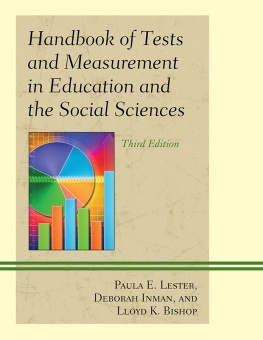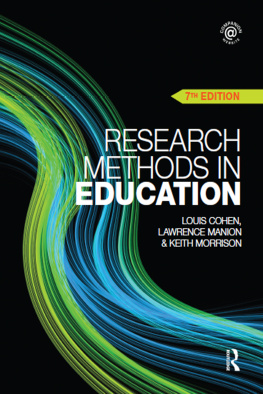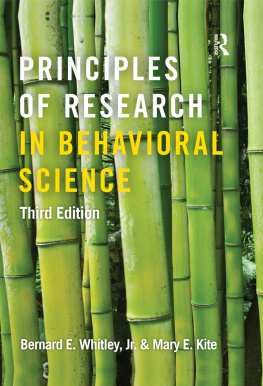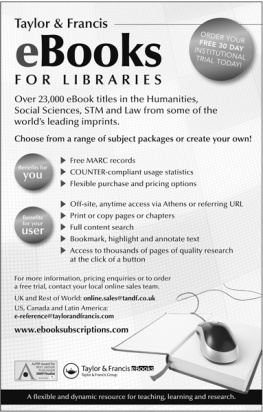Handbook of Tests and Measurement in Education and the Social Sciences
Third Edition
Handbook of Tests and Measurement in Education and the Social Sciences
Third Edition
Paula E. Lester, Deborah Inman, and Lloyd Bishop
Rowman & Littlefield
Lanham Boulder New York London
Published by Rowman & Littlefield
A wholly owned subsidiary of The Rowman & Littlefield Publishing Group, Inc.
4501 Forbes Boulevard, Suite 200, Lanham, Maryland 20706
www.rowman.com
Unit A, Whitacre Mews, 26-34 Stannery Street, London SE11 4AB
Copyright 2014 by Paula E. Lester, Deborah Inman, and Lloyd K. Bishop
All rights reserved . No part of this book may be reproduced in any form or by any electronic or mechanical means, including information storage and retrieval systems, without written permission from the publisher, except by a reviewer who may quote passages in a review.
British Library Cataloguing in Publication Information Available
Library of Congress Cataloging-in-Publication Data
Lester, Paula E.
Handbook of tests and measurement in education and the social sciences / Paula E. Lester, Deborah Inman, and Lloyd K. Bishop. -- Third edition.
pages cm
Includes bibliographical references and index.
ISBN 978-1-61048-429-9 (cloth : alk. paper) ISBN 978-1-61048-430-5 (pbk. : alk. paper) ISBN 978-1-61048-431-2 (electronic) 1. Educational tests and measurementsHandbooks, manuals, etc. 2. Social sciencesMethodologyHandbooks, manuals, etc. I. Bishop, Lloyd K. II. Title.
LB3051.L4543 2014
371.26dc23
2014036286
 The paper used in this publication meets the minimum requirements of American National Standard for Information SciencesPermanence of Paper for Printed Library Materials, ANSI/NISO Z39.48-1992.
The paper used in this publication meets the minimum requirements of American National Standard for Information SciencesPermanence of Paper for Printed Library Materials, ANSI/NISO Z39.48-1992.
Printed in the United States of America
Dedicated to
Rose DeMarino Bishop
In Loving Memory
The wind beneath our wings
Introduction
The first two editions of this book focused on the quantitative approaches to measurement and research methods. This edition has been expanded to include the increasing interest and need for qualitative and mixed methods research designs. This third edition is expanded to serve as a broader research handbook with two parts. Part 1 includes an overview of research methods including chapters on quantitative methods, qualitative methods, and mixed methods. Part 2 includes the anthology and instruments, with a review of each measure, that have been updated from the previous editions.
Twenty years ago, Bishop and Lester compiled an anthology of instruments in education and the social sciences. Bibliographic references were provided for more than seven hundred instruments developed over the last forty years in more than thirty related areas. This anthology was based on more than a dozen major reference books that were written in the 1960s and 1970s. Many of these books are no longer in print and not available. These reference books varied in the amount of information provided. Some sources included the actual instrument, while others provided only a summary of the psychometric characteristics. Still other sources presented critiques of instruments and general bibliographic information. Consequently, there was a need to include in one book not only the specific psychometric information about the instruments and bibliographic references related to the instrument, but the actual instrument (published or unpublished). This edition of the handbook was originally published in 1997 for that purpose.
This second edition of the handbook, published in 2000, expanded upon and updated the original handbook. Since 2000, additional areas of interest have emerged and have been included in this third edition. For example, the issue of teacher and principal evaluation has come to the forefront with federal and state legislation. Teachers and principals across the states are now given grades at the end of every year that represent their effectiveness rating. The Annual Professional Performance Review (APPR) is a state-governed process that determines the standards for these ratings and the process for assessing teachers and leaders effectiveness. The details of the evaluation process are determined locally by school districts. Therefore, the indexes contain a section on Instruments Available through Commercial Organizations, which include the latest sources for teacher and principal evaluation instruments.
For many years, quantitative methods (sometimes referred to as verificational research) were considered the best approach for conducting quality research especially in the hard sciences. In fact in the early days of research, quantitative methods were considered superior to qualitative methods. However, as methods from other fields were better understood in the context of strengthening research designs, the barriers between different disciplines became less evident. The social sciences, for example, are now much more open to methods from the humanities and philosophy than they were even twenty years ago. The need for more in-depth and comprehensive understanding of various research questions has resulted in a greater appreciation and need for what qualitative and mixed methods research designs can provide.
Quantitative research incorporates systematic empirical investigations using scientific methods to answer specific questions. Quantitative methods are also used in the social sciences although its origins are from positivism. Quantitative methods refer to the systematic empirical investigation of social phenomena using statistical, mathematical, or computational techniques. Appropriate mathematical measurement of research variables is central to quantitative research because it provides the fundamental connection between empirical observation and mathematical expression of quantitative relationships. Quantitative data are usually numerical requiring the use of various statistical procedures for data analysis and interpretation.
Qualitative research is a method of inquiry used in many different disciplines, although it traditionally emerged in the social sciences with roots from sociology and anthropology (Bogdan and Biklen, 1998), and also referred to as social anthropology. Qualitative research is used for in-depth understanding of human behavior and the reasons of such behavior. The qualitative method investigates the why and how questions of various issues. Qualitative data are most often collected in the field. This goes back to the early work in anthropology where data were collected in the field. Data may be collected through in-depth interviews with study participants and/or observationsobserving activities, behaviors, and actions (referred to as participant observation). One may also review written materials or documents (Patton, 2002). The researcher actually spends time in the setting being studied observing and interviewing the participants. The researcher takes notes of the observations including direct quotes from those interviewed. The data from these field notes are usually very comprehensive and the researcher must turn the notes into narrative descriptions with themes, categories, and examples using content analysis . From this, themes, patterns, clearer understandings, and insights emerge (Patton, 2002, pp. 45).
Mixed and multiple methods research occurs when the research questions require a combination of both quantitative and qualitative methods. Today, in order to address some of the more complex issues in many fields, mixed methods are very common. Research methodology has evolved to another level with the incorporation of both qualitative and quantitative approaches into what is referred to as mixed methods design. The problems addressed by social science researchers are very complex and the use of just qualitative or quantitative methods is often inadequate to address the complexity (Creswell, p. 203). The combined use of these methods results in much stronger research designs to provide a deeper understanding of research problems.
Next page








 The paper used in this publication meets the minimum requirements of American National Standard for Information SciencesPermanence of Paper for Printed Library Materials, ANSI/NISO Z39.48-1992.
The paper used in this publication meets the minimum requirements of American National Standard for Information SciencesPermanence of Paper for Printed Library Materials, ANSI/NISO Z39.48-1992.